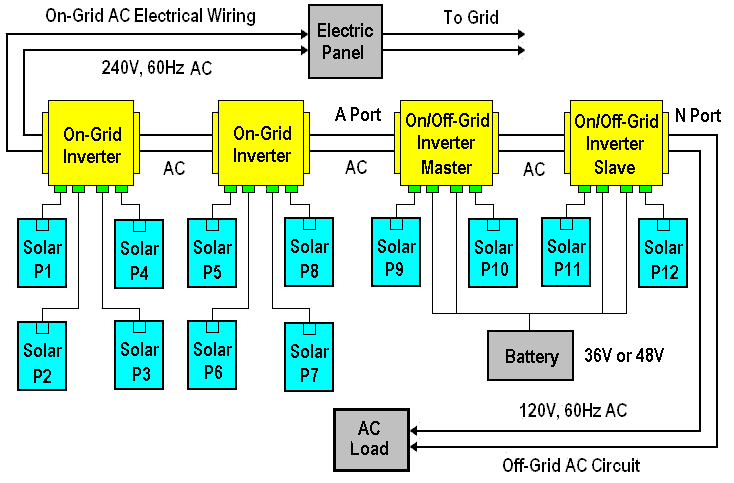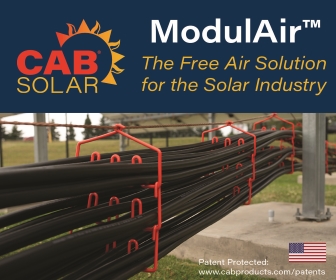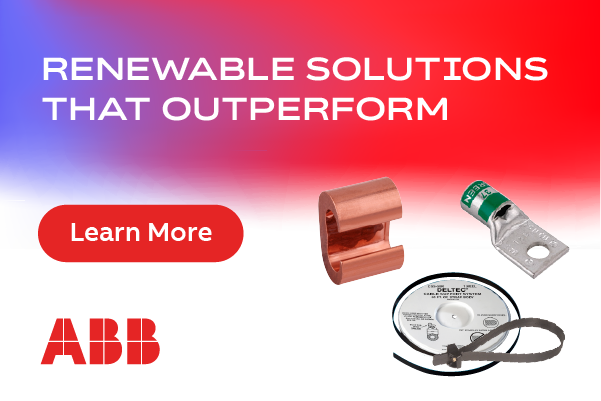Designing a Scalable On/Off-Grid Solar Power System
Changes in temperature, precipitation, and sea level due to global warming are causing severe weather events which can shut down power grids for hours and even weeks. Since modern infrastructure is built upon electricity, losing grid power causes significant disruption and hardship. There is a growing need to have backup power readily available when natural disasters occur.
Most installed solar power systems in the US are on-grid systems. On-grid solar inverters must shutdown almost instantaneously when the grid goes down to keep it safe. These on-grid inverters are designed to deliver power to the grid and cannot run critical AC loads during a power outage. On the other hand, most off-grid power backup systems are complicated and costly to install.
One solution is a scalable on/off-grid solar power system, operating in both on-grid and off-grid modes, and switching between the two automatically depending on grid condition. When using one or more on/off-grid mini-inverters daisy-chained with on-grid mini-inverters, the installation of such a system is simple and cost effective.
AC standards
In North America, split-phase AC standard is used. The Line-to-Line (L1 to L2) output voltage is 240V, and the Line-to-Neutral (L1 to N, or L2 to N) is 120V. An on/off-grid power inverter must supply 240V AC to the grid in its on-grid mode, and 120V or 240V AC in its off-grid mode.
On/off-grid modes
An on/off-grid mini-inverter runs in on-grid or off-grid mode, never both at the same time. When the grid is on, it operates in the on-grid mode sending generated AC power to the grid. When the grid is down, it goes to off-grid mode, automatically powering AC loads. The on-grid AC line may be manually disconnected to "force" the inverter into the off-grid mode.
Battery charging
Most off-grid inverters are called battery inverters because they can only accept battery as DC power inputs. An on/off-grid mini-inverter has multiple input channels, each of which can connect to solar, wind, or battery. This means the inverter can run with or without batteries. Battery charging can be done using a solar charge controller or an AC battery charger.
The general design rules shall include the following:
- A larger system can be designed with multiple on/off-grid sub-systems of different sizes;
- Design the sub-systems based on the critical off-grid AC loads;
- The total on-grid output power from each sub-system can be combined in an electric panel to be sent to the grid;
- Each sub-system will have its own independent off-grid circuit to power the connected AC loads when the grid is down;
- No need to combine the off-grid circuits, doing so could make the system much more complex and costly;
- To use the existing AC circuits to run the AC loads when the grid is down, install proper AC switches to totally isolate the grid AC. A professional licensed electrician should help design and wire the system properly;
- To have a large off-grid system running all the loads of the entire house when the grid is down, it is a good idea to use the AC coupling design where a large battery inverter is used as the lead inverter. The on-grid mini-Inverters discussed in this article can be used to work with the battery inverter and supply solar power to the system.
On/off-grid for electric water heaters
A daisy-chained on/off-grid mini-inverter twin pack connected to 8 solar panels. This powers an electric water heater in the off-grid mode. When the hot water reaches its temperature setpoint, the system automatically switches to the on-grid mode, supplying solar power to the grid. The system can also be set to run in the on-grid mode whenever the grid is on. When the grid is down, the system keeps the electric water heater running in the off-grid mode.
On the roof or ground-level
Most microinverters are installed under the solar panel on the roof. On/off-grid mini-inverters and on-grid mini-inverters in the same family can be installed on the solar racks, if there are no batteries in the system, and an AC wire is run from the roof to inside the house, supporting an off-grid AC circuit for backup power.
If an on/off-grid mini-inverter must connect to batteries, the inverter can be installed in the garage. Its on-grid AC output of the on/off-grid mini-inverter connects to a 20A branch circuit in the electric panel directly. In this case, DC wires from the inverter are run to the solar panels on the roof. A multi-conductor wire is used with junction boxes and MC-4 connectors.
System sizing
Table 1 lists system options. Each inverter is 1.2KW and has 4 input channels connecting to solar, battery, or wind directly. 300W solar panels are used and a 36V or 48V battery connects to multiple input channels in parallel.
Table 1.
| No. | On-Grid Power | Backup Power for Off-Grid Loads | On-Grid Inverter | On/OffGridInverter | Total |
|---|---|---|---|---|---|
| 1 | 1.2KW-4.8KW | 0 | 1-4 | 0 | 4 |
| 2 | 1.2KW | 1.2KW | 0 | 1 | 1 |
| 3 | 2.4KW | 1.2KW | 1 | 1 | 2 |
| 4 | 2.4KW | 2.4KW | 0 | Twin Pack | 2 |
| 5 | 3.6KW | 1.2KW | 2 | 1 | 3 |
| 6 | 3.6KW | 2.4KW | 1 | Twin Pack | 3 |
| 7 | 4.8KW | 1.2KW | 3 | 1 | 4 |
| 8 | 4.8KW | 2.4KW | 2 | Twin Pack | 4 |
| 9 | 6.0KW | 2.4KW | 3 | Twin Pack | 5 |

Figure 2 shows a 4.8KW on/off-grid system including twelve 300W solar panels, one battery, two on-grid mini-inverters, and one on/off-grid mini-inverter twin pack (Table 1, Row 8). The on/off-grid mini-inverter twin pack has 8 input channels; 4 connected to solar panels, and 4 connected to the battery in parallel.
The system produces up to 4.8KW AC power to the grid, but if the battery channels are idle when the grid is on, the system supplies 3.6KW to the grid. When the grid is down, the on/off-grid mini-inverter twin pack produces 1.2KW backup power at night and up to 2.4KW backup power during the day when both solar panels and batteries supply DC power. Note, this system is designed for backup power and should only run critical loads. It may not support a whole house's electrical needs at one time.
On/off-grid system scalability
One key advantage of such a system is its flexibility to scale.
The scalable design is adaptable for small to large-scale on/off-grid solar power systems sending power to the grid, and providing power to run critical electric devices and appliances during a power outage. These simple, scalable on/off-grid solar power systems are affordable to most residential and commercial solar customers.
Dr. George S. Cheng is the CTO at CyboEnergy, Inc.
CyboEnergy, Inc. | www.cyboenergy.com
Volume: 2016 March/April










.png?r=2436)

